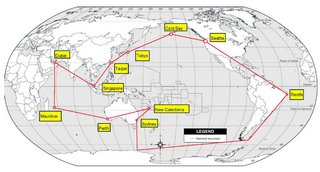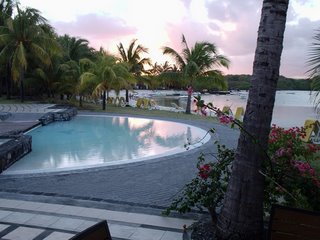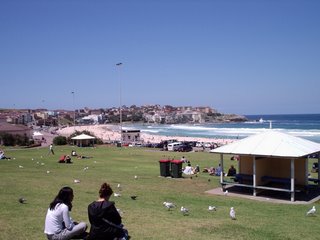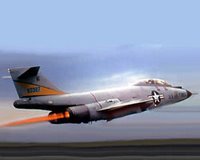In the Fall of 2004, four of my coworkers and I started on an adventure that would take eighteen days to complete. It would involve a trip around the world, but not in the usual sense of east to west. This trip was north to south, almost pole to pole.The map shows where we went, but to get a proper idea of what we did, you need to lay it out on a globe. Our task was to prove the long range reliability of a new and stretched version of the Boeing 777. We left Seattle on Oct 20, and flew south along the coast, then turned north to a tiny island in the Aleutian chain.

We spent much of this flight with one of our two engines shut down -- on purpose! We landed at Cold Bay, taxied to the end of the runway, turned around, and took off again without opening a door or shutting down the engines. Our next destination was Tokyo, again most of this was flown with an engine shut down. If a jet engine could have a soul, these engines should. I've always been partial to General Electric engines, but these give me goose bumps. During this trip, we would be flying on one engine for over 28 hours! Before this adventure was over we would make stops in Dubai, Teipei, Singapore, Mauritius, Perth, Sidney, and Recife, then one final push back to Seattle. This will be something of a photo travel log of this trip.
Tokyo:
We arrived late at Narita, after 16 hours of flight time. The interior of our plane was like a cross between an RV and a computing laboratory. Except, it didn't have beds and it didn't have showers and it didn't have a kitchen - - well it wasn't that much like an RV. A normal cabin would be outfitted months later. We had sleeping bags, and foam or blow up mattresses on board, to get rest when we could, but it's just enough to get by.

After landing, there were about twenty five of us, engineers, pilots, and mechanics, packed onto a too small bus for a very long ride to our hotel in downtown Tokyo.

The next day was for rest, but sightseeing took precidence. After a tour of the Tokyo Tower we went to the Ginza. It's what I think Times Square would be like, crowds of busy people, all moving quickly with somewhere important to go. I liked it very much, and insisted we find a local place for lunch.
Singapore:
The next leg of the journey for me and one other pilot was a commercial flight to Singapore where we would wait for the rest of the crew to bring the plane from Taipei. We used a method of crew leapfrogging so that pilots and mechanics could be in place and rested, to begin a series of repeated flight rotations scheduled as rapidly as a crew change would allow. The plane didn't get any rest.
Singapore was warm and humid. In fact, that was why we were there, to demonstrate that cold-dry to hot-humid cycles could be tolerated. By now, jet lag and long days had caught up with me, so my sightseeing consisted of strolls through the nearby shopping district and an outing for lunch at
Raffles. Singapore is very modern with a huge amount of western influence. There were, of course, McDonalds and Starbuck's, but there were also many other recognizable American places, like Subway Sandwiches and Tony Roma's.
Dubai:

An "Oh, God:30" wake up call on Oct 28 for an early departure from Singapore to Dubai. This is absolute desert on the banks of the Persian Gulf. The only thing breaking up the uniform sand, is man made buildings. There were about thirty of us, so it took a long time to clear immigration and customs. The UAE, of which Dubai is a part, is very westernized. The region has close ties with the United States. When I was there, I thought, "Maybe there's hope."
We visited the
"Burj Al Arab" Hotel .

To get a tour, we were charged for tickets to get in, but they also allowed you to credit the price of the tickets against shopping at the hotel; more souvenirs! After exploring the pool area, and admiring the high tech fountain in the lobby, we took a cab to the
Dubai Hard Rock Cafe for supper. I'm indifferent to it, but my co-workers seem to enjoy a chance to get some comfort food, burgers and barbecue. Of course it's cool to collect t-shirts from Hard Rock Cafe's from all over the world.
Mauritius:
Our next destination was a very welcome break. Mauritius is in the Indian Ocean, about a thousand miles east of Mozambique, with Madagascar half way between. Mostly agricultural, tourism from Europe is a big part of the economy. It felt, to me, very much like Hawaii. The rooms were four to a villa, with the villas widely scattered over the grounds. A beautiful pool was just steps from the lagoon beach.

The Shandrani Hotel provided canoes, kayaks, and power boats to give skiers a short pull around the lagoon. First come, first served, but it was free. After a day of rest, swimming, and photography, we had a fresh seafood supper before retiring for the night. The next day was all PR work. We opened the plane to tours by the "
Air Mauritius" executives and employees. We expected around a hundred people, but got four times that many. Everyone was conscripted to help answer questions by the visitors. We were a hit! I found out after we left, that we made a splash in the local paper, partly because we pulled a "Look, Ma, no hands" stunt when we took off from a convenient intersection of the taxiway and runway, instead of backtaxiing to the very start of the runway, blithely ignoring a thousand feet of usable runway. With our performance, we didn't need it! That got their attention.
Perth:
What was about to happen over the next four days, I'll remember forever, and will, no doubt, bore my grandkids, and anyone else who will listen, to tears, for the rest of my life. From Mauritius, a seven hour flight took us to Perth, Australia. Australians are every bit as fun and hospitable as their reputations indicate.We had the quickest and easiest customs process yet.
One of the first things I was aware of while exploring Perth and Fremantle, was that "I could live here!" Perth was bigger than I expected.

Their population is about 1.5 million. Fremantle is a boat ride from Perth, and is preserved as a historic harbor from the last century. Uh, no, check that, the one before the last century. Tourism is big. It's a good place to buy a
didgeridoo and opal jewelry. No, I didn't buy a didgeridoo, yes, I bought some opal earrings for C. It was their Spring, and the temperature and sunshine were perfect. A lot more walking and picture taking on that day and the next.
But wait! There's more!
Ayers Rock:
We, of course, didn't land on Ayers Rock, but we saw it in a way that few have. Our next leg of the journey was actually two flights, one from Perth to New Caledonia, then a short back track to Sidney. Well, by now, a four hour flight was short! The stop in New Caledonia was just like the one on the Alaskan island, land, turn around and take off again. What happened on the flight from Perth is the most amazing thing I've ever experienced. Our test conditions called for a simulated catastrophic engine failure, rupturing the pressure vessel. That means that we pretend the engine blows up, damages the wall of the cabin, and we lose pressurization. Now, if you are a white knuckle flyer, don't panic, this almost never happens. =insert steely eyed killer grin here=
Here's what that meant to us. Leave Perth, and climb to 30,000 feet, cruise for a while, then shut down the engine, and rapidly descend to 10,000 feet. Once we are at low altitude, we are no longer under the control of any air traffic service. No one can see us on radar, no one can talk to us unless we use the satalite phone system. We're on our own. By the time we made our descent, we were over the red outback, pointed at the heart of Australia. This is where I start channeling
Nevil Shute. We will fly over Ayers Rock, now known as Uluru, and Alice Springs.

When we approached
Uluru, everyone grabbed a camera and scrambled for a window. Without much persuasion, the crew at the controls banked the plane so we could get a better look and eventually made a couple of turns around the rock. Since the top is over 1000 feet above sea level, we came within nine thousand feet of it. In the picture, you can see a road encircling the formation, with vehicles, buildings and a small town at the top. This is the second time I've seen Uluru from the air. Someday, I'll see it from the ground....
Sidney:

Another place I could live! Imagine the scenery of Seattle and the climate of San Diego. Over twelve hours after leaving Perth, we arrived in Sidney to another warm welcome. It was dark when we checked into the hotel, so we all met in the bar on the 24th floor of the Shangri La Hotel.
The nighttime view was spectacular. The next day was my turn to be the "Designated Pilot" at the PR event. When I could break free of my duties, there was no way to rejoin my companions, so I had the cab driver make a detour by Bondi Beach on my way back to the hotel.

I was still in my uniform, so I only spent a few minutes taking pictures. This is headquarters to one of the famous lifesavers clubs. Once back at the hotel, it was a short walk to the harbor. This is THE harbor. The opera house is right there, just as impressive in person as in the pictures. I took a boat tour of the harbor and got a few more pictures.
But wait! There's still more.
Recife:
We might as well set a record while we're at it. Made the papers again. Our next leg was 17,314 kilometers (10,690 miles). 18 hours, 25 minutes from lift off to touchdown. No one had ever flown from Australia to Brazil before. By the way, lets tag the Antarctic circle, too. We flew due south from Sidney, down to Latitude 65 south. Then east, uh, west, wait.... I'm confused. We turned left! Now we're on a beeline for the Straights of Magellan. Beneath us is the outer reach of the south polar ice sheet. Icebergs just barely show up as bright white flecks. Once we arrive over the southern tip of South America, it seems like we would turn left to fly up its east coast, but a turn is not necessary. It's a trick of "Great Circle" navigation. But fly up the coastline, we did. Tierra del Fuego, Argentina, Uruguay, then Brazil. We overflew Rio, and could make out Sugar Loaf through the scattered clouds. Recife is located just on the north eastern shoulder of Brazil, just before the coastline bends back to the west. More beaches, more pictures, more souvenir shopping, more sightseeing... ho hum.

No, I never get tired of it. On the drive from the airport to our beach front hotel, we saw the slum areas, that convinced us to stay away from the interior of the city. This is, again, a recreation area for Europeans, as well as Americans. The cost of living, or vacationing, here is so low that it compensates for the extra airfare.
We had a day off to rest up from the long flight and to get ready for one that will be almost as long. Mostly, I just walked the beach, some of us took a cab to a mall-like shopping area, then, later that night, we went to a "Gaucho" style restuarant. The emphasis is on roasted meat served on a sword-like skewer. We all ate way too much, but had a lot of fun.
Home:
One last early checkout for another long flight home. Not a record, but extraordinary, never the less. Fourteen hours from Recife to Seattle, across the mouth of the Amazon River, we touch US airspace over Florida, only six more hours, and we'll be home, and we're all ready!











